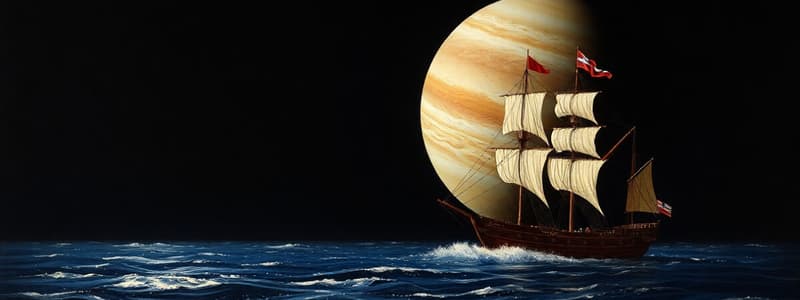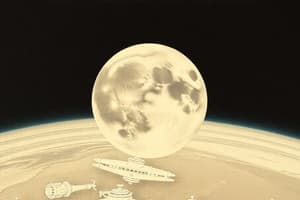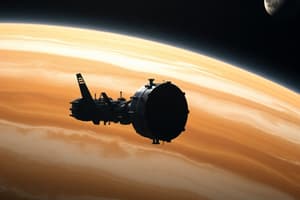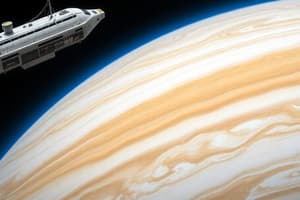Podcast
Questions and Answers
Europa Clipper's mission priorities include understanding the intersection of which two key areas?
Europa Clipper's mission priorities include understanding the intersection of which two key areas?
- Volcanic activity and tectonic plates
- Radiation belts and solar winds
- Ice and ocean (correct)
- Atmosphere and magnetic field
What is the primary reason Europa Clipper will study the chemical composition and geology of Europa?
What is the primary reason Europa Clipper will study the chemical composition and geology of Europa?
- To identify valuable mineral resources
- To create detailed topographical maps
- To assess the moon's potential for sustaining life (correct)
- To predict future asteroid impacts
Why is the radiation environment around Europa considered a significant challenge for the Europa Clipper mission?
Why is the radiation environment around Europa considered a significant challenge for the Europa Clipper mission?
- It interferes with the spacecraft's communication systems
- It rapidly degrades the spacecraft's instruments and electronics (correct)
- It makes accurate navigation exceedingly difficult
- It increases the risk of collisions with space debris
Which aspect of Europa is considered most exciting to scientists, motivating the Europa Clipper mission?
Which aspect of Europa is considered most exciting to scientists, motivating the Europa Clipper mission?
What key question is Europa Clipper designed to answer regarding Europa?
What key question is Europa Clipper designed to answer regarding Europa?
What characteristics and capabilities differentiate the Europa Clipper mission from previous space exploration endeavors?
What characteristics and capabilities differentiate the Europa Clipper mission from previous space exploration endeavors?
How does Europa Clipper gather data without landing on Europa's surface?
How does Europa Clipper gather data without landing on Europa's surface?
Which of the following is NOT a primary focus of the Europa Clipper mission?
Which of the following is NOT a primary focus of the Europa Clipper mission?
Why does the Europa Clipper mission involve orbiting Jupiter with flybys of Europa, rather than directly orbiting Europa?
Why does the Europa Clipper mission involve orbiting Jupiter with flybys of Europa, rather than directly orbiting Europa?
What is the primary purpose of the electronics vault on the Europa Clipper spacecraft?
What is the primary purpose of the electronics vault on the Europa Clipper spacecraft?
What critical role do gravity assists play in the Europa Clipper mission's trajectory to Jupiter?
What critical role do gravity assists play in the Europa Clipper mission's trajectory to Jupiter?
What does the comparison of the Europa Clipper's weight to that of an African elephant illustrate about the spacecraft?
What does the comparison of the Europa Clipper's weight to that of an African elephant illustrate about the spacecraft?
What is the significance of studying Europa's potential ocean, which has likely existed for 4 billion years?
What is the significance of studying Europa's potential ocean, which has likely existed for 4 billion years?
How does Jupiter's magnetosphere present a challenge to the Europa Clipper mission?
How does Jupiter's magnetosphere present a challenge to the Europa Clipper mission?
What is implied about the current state of space exploration based on the statement, 'We are in a golden age of robotic space flight exploration?'
What is implied about the current state of space exploration based on the statement, 'We are in a golden age of robotic space flight exploration?'
What does the analogy comparing the Europa Clipper's solar arrays to the Statue of Liberty emphasize?
What does the analogy comparing the Europa Clipper's solar arrays to the Statue of Liberty emphasize?
Flashcards
Europa Clipper
Europa Clipper
NASA mission dedicated to studying Jupiter's moon Europa, assessing its potential for life.
Europa's Subsurface Ocean
Europa's Subsurface Ocean
A global ocean of water beneath Europa's icy surface.
Europa Clipper's Goal
Europa Clipper's Goal
To determine if Europa has water, energy, and the right chemistry to support life.
Europa Clipper's Equipment
Europa Clipper's Equipment
Signup and view all the flashcards
Europa Clipper's Trajectory
Europa Clipper's Trajectory
Signup and view all the flashcards
Europa Clipper Launch
Europa Clipper Launch
Signup and view all the flashcards
Europa Clipper Arrival
Europa Clipper Arrival
Signup and view all the flashcards
Europa Clipper's Studies
Europa Clipper's Studies
Signup and view all the flashcards
Europa Clipper's Solar Arrays
Europa Clipper's Solar Arrays
Signup and view all the flashcards
Jupiter's Radiation Environment
Jupiter's Radiation Environment
Signup and view all the flashcards
Gravity Assist
Gravity Assist
Signup and view all the flashcards
Flyby Strategy
Flyby Strategy
Signup and view all the flashcards
Electronics Vault
Electronics Vault
Signup and view all the flashcards
Travel Time to Jupiter
Travel Time to Jupiter
Signup and view all the flashcards
Robotic Space Exploration
Robotic Space Exploration
Signup and view all the flashcards
Study Notes
- Europa Clipper is NASA's first mission dedicated to studying Jupiter's icy moon Europa.
- Europa is considered one of the most promising places in the solar system to find an environment suitable for life.
- Evidence suggests Europa has a global ocean of water beneath its frozen surface.
- The mission aims to determine if Europa has the right chemistry and energy to sustain life.
- Europa Clipper is not a life-detection mission but will assess Europa's potential habitability.
- The spacecraft is equipped with nine instruments and will also conduct a gravity experiment.
- It will orbit Jupiter and perform 49 flybys of Europa.
- The mission will gather data to understand Europa's geology, composition, and interior
- The mission is scheduled to launch in October 2024 from Kennedy Space Center in Florida.
- Europa Clipper is expected to arrive at Jupiter in 2030.
- Europa is about the size of Earth's moon.
- It has an icy surface believed to conceal a subsurface ocean.
- Scientists believe Europa has the three key ingredients to support life: water, energy, and essential chemical building blocks.
- The mission will explore the ice and ocean, studying the intersection between them.
- It will investigate Europa's chemical composition, geology, and current activity.
- Five of the instruments are remote-sensing instruments that measure light reflected off Europa.
- Examples include cameras and spectrometers.
- The other four instruments measure the environment around Europa.
- These instruments sniff gases or dust.
- Europa Clipper is the largest spacecraft NASA has ever built for a planetary mission.
- The spacecraft weighs 13,000 pounds, equivalent to about six and a half tons.
- The solar arrays are so large that if placed at the toes of the Statue of Liberty, they would reach the Statue's crown.
- The solar arrays are designed to withstand constant radiation exposure throughout the mission.
- Jupiter's radiation environment is intense as Europa sits in the worst part of it.
- Jupiter acts like a giant particle accelerator.
- Charged particles trapped in Jupiter's magnetosphere rotate, slamming into Europa and the spacecraft.
- The spacecraft is protected from radiation in two ways:
- Minimizing time spent near Europa by orbiting Jupiter and performing flybys.
- Encasing sensitive electronics in an electronics vault made of about one-third of an inch of aluminum.
- Each flyby exposes the spacecraft to the equivalent of a few million chest X-rays.
- The journey from Earth to Jupiter will take about 5 ½ years.
- The spacecraft will perform flybys of Mars and Earth for gravity assists.
Studying That Suits You
Use AI to generate personalized quizzes and flashcards to suit your learning preferences.
Description
NASA's Europa Clipper mission is dedicated to exploring Jupiter's icy moon, Europa, to assess its habitability. The mission, scheduled to launch in October 2024, aims to determine if Europa possesses the necessary chemistry and energy to support life. The spacecraft will conduct 49 flybys of Europa, gathering data on its geology, composition, and interior to understand its potential for life.





